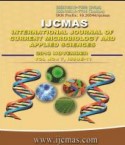


 National Academy of Agricultural Sciences (NAAS)
National Academy of Agricultural Sciences (NAAS)

|
PRINT ISSN : 2319-7692
Online ISSN : 2319-7706 Issues : 12 per year Publisher : Excellent Publishers Email : editorijcmas@gmail.com / submit@ijcmas.com Editor-in-chief: Dr.M.Prakash Index Copernicus ICV 2018: 95.39 NAAS RATING 2020: 5.38 |
Scab is the most serious disease of apple, particularly in years with cool wet springs and summers. Symptoms occur on leaf blade, fruit, petioles, sepals, blossoms, young shoots, and bud scales. The lesion increase in size as olive green colored which become progressively darker brown raised and velvety in appearance due to the abundant production of conidiophores and conidia. Symptoms are likely to appears on the undersides of new leaves The scab lesions on the lower leaf surface as often extending along the veins and the midrib and appearing diffuse, with irregular, poorly defined borders, thus unlike the discrete, sharply delineated lesions common on the leaf blade. Later, as the leaves unfold, both surfaces are exposed and can become infected. Foliar symptoms that develop in autumn are often quite different in appearance from the olivacious, velvety spot. Occasionally the underlying cells of the lesion turn brown and die, making lesions visible on the both the surfaces. Twig and blossom infection appear as small scab spot, but at most places they are uncommon and of little importance. The lesion appears on the blossom as an olivaceous spot on the calyx. On mature apples, smaller, secondary lesions often develop near a large primary scab lesion. Fruit lesions are usually very small at first, and, compared with leaf lesions, they usually enlarge more slowly, are dark-coloured, and are more sharply bordered. Early infection can kill young meristematic tissue near the fruit surface, which develop unevenly. The fruit shape is also often distorted as a result of early infection. Older lesions become bare, brown, and corky in the center as the fungus dies. The margins remain black, sometime surrounded with a whitish band of loosened cuticle. Scab lesions develop more slowly when infections occur late in the season, and they may not become visible until the apples are in storage. These spots are usually smaller (pin-head or pinpoint scab) sunken black lesions which lack the olivaceous velvety appearance of lesions on young fruit. Imperfect (Asexual) stage and perfect (Sexual) stages of the fungus have been encountered in nature. The perfect or perithecial stage (Venturia inaequalis (cke.) Wint.) Saprophytic, while imperfect or conidial stage (Spilocea pomi Fr.) is parasitic. Venturia inaequalis produces pseudothecia in a stroma in overwintered leaves on the orchard floor. The pseudothecia are negatively geotrophic dark brown to black, globose (90 - 150 µm in diameter) amphigenous, scattered grouped, with or without setae and have short beak and a distinct ostiole with single celled bristles at the apex. Conidiophores arise from subcuticular layer of intraepidermal mycelium which forms radiating plates and are simple cylindrical, pale to mid brown to olivaceous-brown, erect, closely septate, sometimes swollen at the base, and variable in length up to 90 µm long and 5-6 µm thick. Conidia are produced singly at the tip of a conidiophores and then successively by proliferation through scars of the fallen conidia that result in characteristics and distinct on the conidiophores.
 |
 |
 |
 |
 |